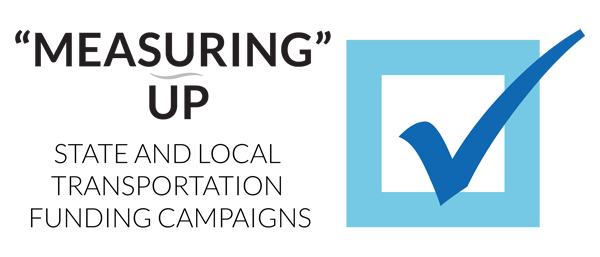Developing State Enabling Legislation to Support Your Local Goals
-> Next primer: read about recent legislation allowing more funding
Experience has shown that voters, when given the chance, are typically eager to support new revenue for local transportation priorities. Typically the decision to impose the tax must be taken first by the governing legislative body of the jurisdiction, such as the county board of commissioners. In many – but not all – cases, a voter referendum is then required. This approach allows local communities to raise their own funds to pay for projects important to them, without having to gain the support of the entire state.
Voters only have this opportunity, however, if the state they live in has authorized local communities to raise revenues through ballot measures. State enabling laws are a threshold requirement that must be in place before local ballot measures can even be considered. State enabling laws can govern many aspects of local ballot measures, including the type of revenue that can be raised, the number of years that the revenue can be collected, the process for getting a measure on the ballot, the permissible uses for the revenue, and sometimes even the exact language that must be presented to the voters.
All state enabling laws are not created equal. Variations in voter thresholds, sunset provisions, permissible uses of funds, and other factors can make it easier or harder for local ballot measures to succeed. The following sections discuss key elements that should be considered when drafting enabling legislation, whether starting from scratch in a state that lacks such laws, or as part of an effort to improve an enabling law already on the books.
Click to expand or collapse a section
State enabling laws typically specify the required percentage of voters needed to pass the ballot measure. In most cases, a simple majority is all that is needed. In some states, however, a super-majority is required. California now requires a two-thirds majority (66.67%) for new fees or taxes. The impact of this high threshold was clearly illustrated in 2012 when Measure J, which would have extended the existing transportation sales tax in Los Angeles past 2039, failed despite 66.1% of voters supporting it. There have been efforts in California following Measure J’s failure to change state law to lower the voter threshold required for passage of local option transportation taxes to 55%.
Many enabling laws specify the number of years during which the revenue can be collected before the collection must go back to the voters. Ten, twenty, and even thirty year timeframes are common, but shorter sunset provisions also exist. In Michigan, voters must frequently go to the ballot to reauthorize property tax collections for public transportation, as the enabling legislation specifies that such levies can be authorized for no more than five years at a time. (Michigan Compiled Laws, 124.468 Tax levy; collection.) The advantage of a longer sunset period is, of course, that once enacted, the new revenue source can provide funding certainty for a longer period, rather than requiring frequent reauthorization campaigns that put future funding at risk.
Most state enabling legislation provides authorization to all local governments within a state, such as counties and cities, to go to the ballot. In some cases, however, ballot measures are allowed only as regional measures. In those cases, the way that the region is defined can have an impact on the ultimate outcome. In Indiana, the legislature recently authorized six counties in the Indianapolis region to raise their own funds for transit. Along the way, there was significant debate about which counties should be included in the list, since some believed that the more rural counties might make it more difficult to pass a regional ballot measure for transit.
Given the ever-expanding list of critical transportation investment needs, a broad definition of permissible uses has value in enabling legislation. Legislation that is multi-modal and supportive of new capital projects as well as ongoing maintenance and operations needs can increase the chances of legislative success. Broadly defined permissible uses in the enabling legislation will provide the opportunity for the subsequent ballot measure campaign to focus on a limited number of investments with the highest public support.
For example, maintenance of the existing transportation system is increasingly a public priority, but many states restrict local funding authorizations to only new capital projects that expand the transportation system. Having a broad set of permissible uses can also help to address social equity concerns, by allowing local communities to develop a suite of transportation projects designed to meet the needs of people of all income levels. Finally, legislation that has broad permissible uses may also be helpful as authorization for future ballot measures that would otherwise require additional legislation. Among the benefits would be a means to seek local funding for new transportation infrastructure needs that involve new technologies unimagined when the state enabling legislation is passed. Recent examples in California include plug-in electric vehicle charger stations and transit smart card systems.
Even when there is a clear need to invest in the transportation system, fiscally conservative legislators can be reluctant to pass legislation that implies, even indirectly, that they support raising new taxes or fees. In these cases, it may be important that the enabling legislation clearly emphasize that it is providing a tool to empower local decision-making. It may also be critical to consider timing of when any ballot-approved revenue would become available. For example, in the Atlanta referendum experience, proponents overcame political opposition by including conditions that no revenue would be raised until the completion of the governor’s second and final term and shaped enabling legislation that left the decision of whether to tax themselves directly in the hands of local voters.
[accordion-group title=”The Balance between Flexibility and Accountability
-> Next primer: read about recent legislation allowing more funding






